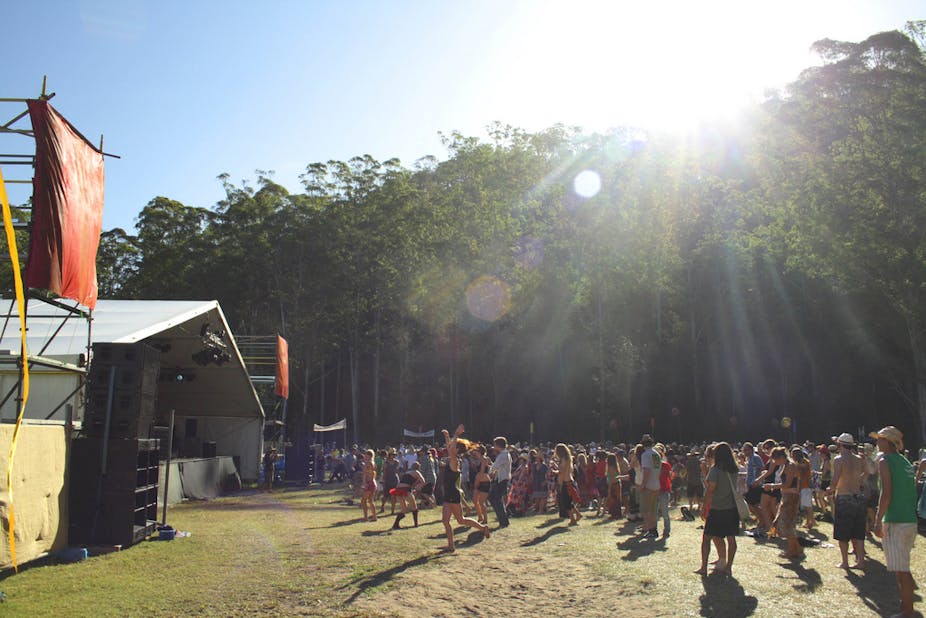Festivals are fun activities - we go to meet up with friends and family, escape the hum drum of daily life, and to be exposed to new cultural forms or simply to be entertained.
Rarely do we consider the demands our attendance makes on our environment, yet like all human activities festivals require resources – water, energy, land, equipment, food and products of various types. Given that many festivals, even at the local level, can involve thousands of attendees these requirements bring with them the potential for negative environmental impacts.
The festival site
Take an imaginary walk with me through a typical “greenfield” festival site. As we enter the festival gate you will notice that placed strategically throughout the site are a number of marquees used for the sale of food and beverages, along with stalls for the sale of various types of merchandise.
As you look beyond these you will see a vast array of other items key to the delivery of such an event - lighting towers, water tanks, signage, fencing/barricades, stage(s), temporary toilets and rubbish bins – all of which needed to be transported to, and will later need to be taken away from, the site.
You will also notice the festival’s need for power has been met by cabling electrical services to various site locations and/or by the strategic placement of generators. Water may also have been plumbed to selected areas.
As you look beyond the festival site itself you will see a substantial dedicated car parking area, along with a bus drop off/pick up location.
Given this scene, it is not hard to imagine that during the set up, operational and post event phases of this, and indeed all festivals, environmental impacts will occur. These impacts fall broadly into the categories of: CO2 emissions (such as from transport and power usage); waste generation (containers, food scraps, grey water and sewerage); consumption of non-renewable resources (including fuel associated with energy provision); and possible damage to the site itself from foot and vehicle traffic.
Sustainable efforts
Many (but not all) festival organisers from both the private and public sector are conscious of the need to reduce or eliminate the types of environmental impacts previously noted.
This desire results, at least in part, from pressure from a more environmentally literate audience. Additionally, the event industry more generally has accepted the need to engage directly with the challenge of environmental sustainability and recognises efforts in this area can reduce operational costs.
At the national level, events such as the Woodford Folk Festival (Queensland) and the Peats Ridge Sustainable Arts and Music Festival (New South Wales) are sustainability beacons to the festival sector.
These two events employ a range of environmental initiatives, including:
- treating their sewerage and grey water on-site
- reducing waste to landfill through recycling, composting and eliminating the use of products not suitable for such
- using renewable fuels
- encouraging and facilitating the use on site of only locally sourced organic food (thus reducing the carbon footprint of food provision)
- providing and encouraging the use of public transport
- incorporating environmentally themed talks into their programs
- enhancing the ecology of their sites through using festival resources for habitat restoration.
Australian festivals are not alone in tackling the sustainability challenge. A number of iconic overseas festivals, such as Glastonbury (UK) and Roskilde Festival (Denmark) have well developed programs in this area.

Rising standards
In 2012, the interest in environmental sustainability among festivals globally gave rise to an International Standard for Sustainable Event Management (ISO 20121). It seeks to provide a systematic basis for approaching the challenge of producing more sustainable events. And recently, organisations have emerged to help festivals in this area, most notably A Greener Festival and the Sustainable Event Alliance.
Software tools have also been developed for this purpose such as Carbon Calculators and the Sustainable Event Management Solution Tool. Festival organisers can take advantage of substantial online databases of material to “green” their festivals; see, for example, the Australian Centre for Event Management’s environmental resources database.
The festival sector has become proactive in the area of environmental sustainability, though the efforts of individual events vary enormously. It is also important to note that the adoption of environmentally friendly practices does not necessarily guarantee, or link to, longevity as the recently (2013) bankrupted Peats Ridge Sustainable Arts and Music Festival indicates.
What the discussion here does point to, however, is an emerging environmental ethos that is quickly being incorporated as a “business as usual” element into the overall process of festival production.

